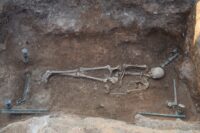 The first intact bed burial ever found in Greece has been unearthed in Mavropigi, a village in the Kozani regional unit of Western Macedonia. The 1st century B.C. grave was discovered when a modern home was demolished as part of the expansion of a lignite mine. Under the foundations of the demolished house where the skeletal remains of an adult woman who had been laid to her eternal rest atop a bronze and wood bed. The wood decomposed over the century, but the bronze rails and bedposts survived intact.
The first intact bed burial ever found in Greece has been unearthed in Mavropigi, a village in the Kozani regional unit of Western Macedonia. The 1st century B.C. grave was discovered when a modern home was demolished as part of the expansion of a lignite mine. Under the foundations of the demolished house where the skeletal remains of an adult woman who had been laid to her eternal rest atop a bronze and wood bed. The wood decomposed over the century, but the bronze rails and bedposts survived intact.
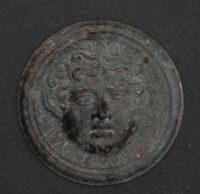 The practice of laying the dead on beds in their graves was widespread in this part of Macedonia during the 2nd and 1st century B.C., but they were made out of wood so the only archaeological material to survive decomposition was the iron nails. Archaeologists have only been able to infer from the placement of the nails that a grave was a bed burial. The Mavropigi grave is the first to preserve all non-organic elements of the bed in situ which makes it the only confirmed ancient bed burial in Greece.
The practice of laying the dead on beds in their graves was widespread in this part of Macedonia during the 2nd and 1st century B.C., but they were made out of wood so the only archaeological material to survive decomposition was the iron nails. Archaeologists have only been able to infer from the placement of the nails that a grave was a bed burial. The Mavropigi grave is the first to preserve all non-organic elements of the bed in situ which makes it the only confirmed ancient bed burial in Greece.
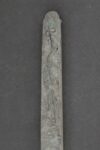 Expensively furnished, such graves are often indicators of the deceased’s high status, and the woman in this grave was buried so richly archaeologists have reason to believe she belonged to the royal family who ruled the area in the late Hellenistic period. The bed would have been the apex of luxury in its time. It is two meters (6.5 feet) long, 90 cm (three feet) wide and 40 cm high (1.3 feet) and was decorated with fine carvings including the head of a mermaid and a long-legged aquatic bird holding a snake in its mouth.
Expensively furnished, such graves are often indicators of the deceased’s high status, and the woman in this grave was buried so richly archaeologists have reason to believe she belonged to the royal family who ruled the area in the late Hellenistic period. The bed would have been the apex of luxury in its time. It is two meters (6.5 feet) long, 90 cm (three feet) wide and 40 cm high (1.3 feet) and was decorated with fine carvings including the head of a mermaid and a long-legged aquatic bird holding a snake in its mouth.
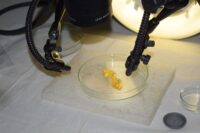 Other exceptional grave goods attest to her great wealth and status. She had a gold plate in her mouth and ten gold double laurel leaves were found on her head. The leaves are pierced, so they were probably part of a wreath or veil made of leather or fabric that has disintegrated. Gold threads were found in her right hand, perhaps the remnants of an embroidered textile that she wore or that was draped over her. She was also buried with a bone needle and four clay censers, one glass censer and a clay amphora.
Other exceptional grave goods attest to her great wealth and status. She had a gold plate in her mouth and ten gold double laurel leaves were found on her head. The leaves are pierced, so they were probably part of a wreath or veil made of leather or fabric that has disintegrated. Gold threads were found in her right hand, perhaps the remnants of an embroidered textile that she wore or that was draped over her. She was also buried with a bone needle and four clay censers, one glass censer and a clay amphora.
The laurel leaf is the sacred plant of Apollo, and the snake in the bed decoration may also be connected to Apollo in his role as slayer of the giant serpent Python. The remains of a sanctuary dedicated to Apollo have been found in Mavropigi, so it’s possible the woman in the bed burial held a position of religious authority in connection to the worship of Apollo.
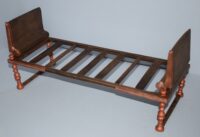 The skeletal remains have been transferred to the conservation laboratory of the Archaeological Museum of Aiani where they will be studied to confirm sex and age and hopefully cause of death. Archaeologists have created a miniature model reconstructing the bed with its wooden parts. They estimated the placement of the missing elements based on excavation data, radiography and CT scans of the bedposts. The Ephorate of Antiquities of Kozani wants to create a full-size replica to put on permanent display at the Archaeological Museum of Aiani.
The skeletal remains have been transferred to the conservation laboratory of the Archaeological Museum of Aiani where they will be studied to confirm sex and age and hopefully cause of death. Archaeologists have created a miniature model reconstructing the bed with its wooden parts. They estimated the placement of the missing elements based on excavation data, radiography and CT scans of the bedposts. The Ephorate of Antiquities of Kozani wants to create a full-size replica to put on permanent display at the Archaeological Museum of Aiani.
Those ‘bed burials’ are also known from northern Europe, and in at least one case the entire ‘bed’ survived:
en.wikipedia.org/wiki/Glauberg#The_Keltenfürst_(Celtic_prince)_of_Glauberg
en.wikipedia.org/wiki/Hochdorf_Chieftain’s_Grave#Gallery
commons.wikimedia.org/wiki/File:Totenliege-Hochdorf-by-1rhb-cr.jpg
Golden wreaths (complete with twigs, leaves and acorns) are likewise known from other Thracian graves:
en.wikipedia.org/wiki/Thracian_Tomb_of_Sveshtari
en.wikipedia.org/wiki/Tomb_of_Seuthes_III
That lady seems to have had a rather strong right arm 😮 Was there any weaponry found? Allegedly, Orpheus was cut to pieces by tatooed Thracian Maenads, who –of course– made it look like an “accident”:
commons.wikimedia.org/wiki/File:Pistoxenos_Painter_ARV_860_2_Thracian_woman_killing_Orpheus_-_young_riders.jpg
commons.wikimedia.org/wiki/File:Phiale_Painter_ARV_1014_2_Thracian_woman_with_sword_killing_Orpheus_-_draped_youth_(01).jpg
——–
PS: “Mavropigi”, I would translate as dark or ‘muddy waters’ (but my Greek is rather muddy. However, πηγίον is a spring and ἡ πηγή means running water).
How can you tell that the head was that of a mermaid?
…very good question, Virginia.
The Greek term γοργόνα (gorgóna) translates as “mermaid”, but actually –here– they are older than the ones that we are usually familiar with.
In fact, what we speak of in this context is a “Gorgon” (from γοργός = grim, fierce, terrible; γοργονεία = coral):
en.wikipedia.org/wiki/Gorgon
commons.wikimedia.org/wiki/Category:Gorgons
:hattip: